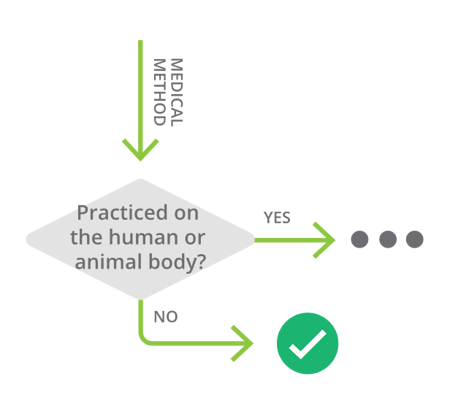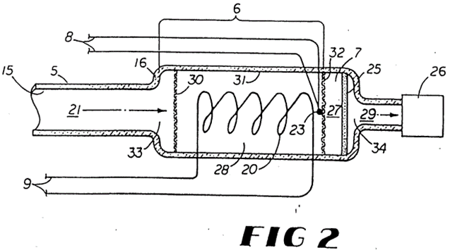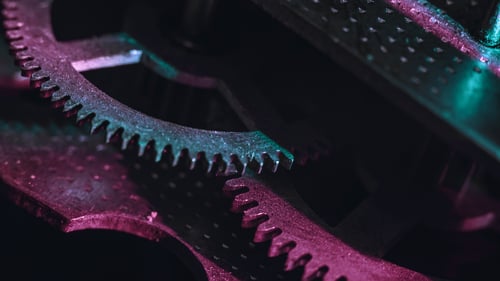At a glance: In the present blog series a guide on patenting medical inventions is provided. Part 2 deals with the question whether the method is practiced on the human or animal body. If not, e.g., an in-vitro method, the method is not excluded from patent protection.
What’s the matter?
Only if a method is practised on the human or animal body, a method qualifies as medical method that is excluded from patent protection.
Why is it important?
Depending on how your invention is described in your patent application you may not be able to exclude steps that are practised on the human or animal body from the claims to avoid exclusion from patent protection.
What’s the critical point?
To avoid exclusion from patentability of a method related to a medical invention it is very important to determine for each step of the method whether its performance implies any interaction with the human or animal body.
What needs to be kept in mind?
It must be established before filing whether a method related to a medical invention can be described and claimed without any (technical) step that is practised on the human or animal body.
Overview
The following flowchart provides some guidance for assessing whether a medical invention is excluded from patentability. Each step of the flowchart will be discussed one by one in the present series of blog posts.
Step 2: Practised on the human or animal body?
According to the German Patent Act (PatG) and the European Patent Convention (EPC) medical methods, i.e., surgical and therapeutic as well as diagnostic methods that are practised on the human or animal body are excluded from patent protection[1]. As described in the previous blog post, any practitioner and clinician should be free in her or his choice of the best treatment for patients without having to consider any legal consequences due to patent infringement. Consequently, if a method relating to a medical invention is practised on the human or animal body, the method probably qualifies as medical method and is excluded form patent protection[2].

In G 1/04, which is the core decision for diagnostic methods that is nevertheless also in part applicable to surgical and therapeutic methods, the Enlarged Board of Appeal (EBoA) found that the exclusion of medical methods is to be interpreted narrowly. In view of surgical and therapeutic methods this means that only if a step is practised on the human or animal body, said step qualifies as surgical or therapeutic step. In view of diagnostic methods this means that all technical steps (discussed in a subsequent blog post) must be practised on the human or animal body. A specific type or intensity of interaction with the human or animal body is however not required. Further, only if a step is practised on the living human/animal body, the respective method can be qualified as a medical method, which means that, in particular, in-vitro methods are not excluded from patent protection[3].
Case law example: Treatment of gas (T 0238/06)
Claim 1 of the underlying patent application EP 1 386 629 A2 related to a:
Method of treating gas for use in an endoscopic procedure comprising:
directing gas into a treatment chamber;
treating the gas (heating and humidifying); and
providing the treated gas (for the endoscopic procedure).

Insufflation gases for insufflating a body cavity of a patient during an endoscopic or laparoscopic procedure are pre-treated (heated and humidified) prior to introduction of the gases into the cavity of the patient. Here the step of insufflating a cavity of a patient with gas is undoubtedly a medical step. But all claimed method steps only relate to the pre-treatment of the insufflation gas performed in a chamber (reference sign 6 in Fig. 2 above) independently of the patient. Thus, no claimed step requires any interaction with the patient. The claimed method is consequently not practised on the human or animal body and not excluded from patentability.
If, however, the step of flowing the pre-treated gas into patient was also included in claim 1, the method would qualify as a surgical method and be excluded from patent protection.
Summary
When you consider patenting a medical invention in form of a method claim, you should determine on which material the relevant step(s) are practised (in-vivo vs. in-vitro). If any step is indeed practiced on the living human or animal body (in-vivo) further steps of assessing whether the respective method could qualify as medical method and fall under the exclusion from patent protection must be carried out (discussed in the subsequent blog posts).
Download
Here you can download a summary of the above blog post for your quick review.
[1] Art. 53(c) sentence 1 EPC, § 2a Abs. 1 Nr. 2 sentence 1 PatG
[2] G 1/04, T 789/96, T 245/87
[3] T 0182/90
Read the other articles on this blog series:
Part 1: IP Diagnosis: Is my medical invention patentable? Part 1 – Product or method?
Part 5: IP Diagnosis: Is my medical invention patentable? Part 5 – Treatment by surgery





